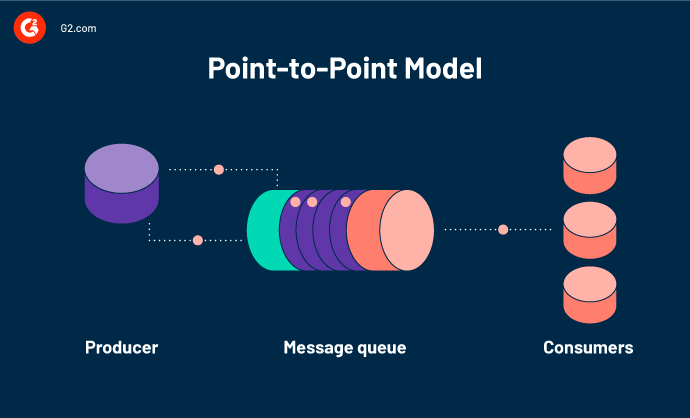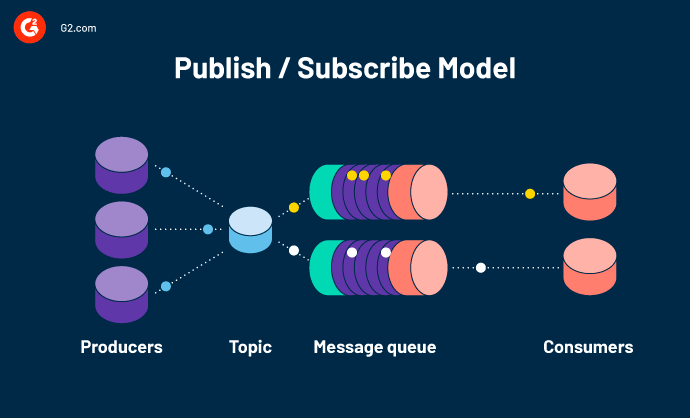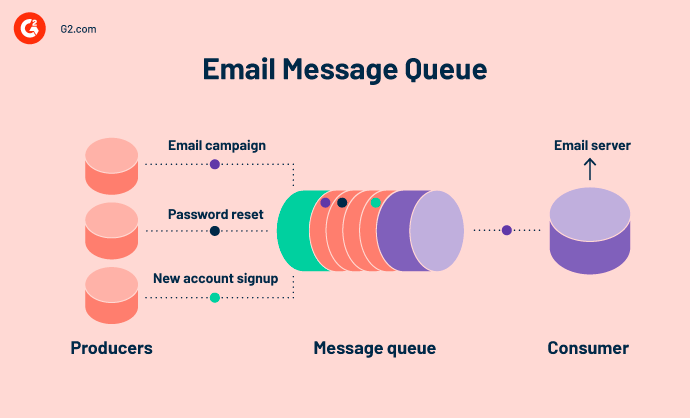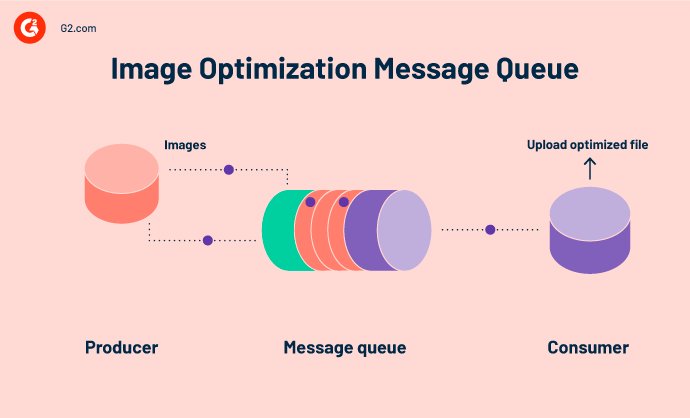Communication is fundamental to humans, and applications are no different.
Just as people rely on proactive communication to collaborate and connect, applications depend on efficient communication to function seamlessly.
But how exactly do applications exchange information and coordinate tasks? The answer lies in message queues—a powerful tool that enables applications to share data, distribute workloads, and operate reliably.
What is a message queue (MQ)?
A message queue is a part of software that helps applications communicate with each other by storing messages. It acts as a temporary holding area where messages are queued until the receiving application is ready to process them. MQ is commonly used in microservices and serverless environments to manage communication efficiently.
Message queue (MQ) software transmits information between two IT systems with a small piece of code that doesn't care if the receiver application takes its sweet time to respond. This information can be data, metadata, signals, or all three. Think of it like sending a text; the message sits in the recipient’s inbox until they’re ready to read and respond.
Understanding how applications communicate and handle tasks is critical for building scalable, efficient, and resilient systems. Using message queues can transform your architecture.
Why use a message queue?
Message queues typically decouple parts of an application. They have a significant advantage over other solutions because they are inherently asynchronous by design.
Today’s enterprise computer infrastructures are complicated and highly dispersed. Message integrates applications and services across platforms with a single, robust, secure, and shared pipeline. This safeguards against data loss and guarantees that systems continue to work even with unstable connectivity.
However, message queues aren't just for queuing. They're critical in any operation that sends or receives information between systems. Message queues are used in projects that involve several parts because they help avoid bottlenecks and keep everything running smoothly as the load increases. They also provide resiliency if some of the project's components fail or go offline temporarily.
Before preaching about queues, I want to clarify that message queues are not the magic bullet for solving all performance issues in your application code. However, they can give you plenty of time to continue development when used correctly. Simultaneously, the underlying system also takes time to process the messages in the queue.
Want to learn more about Message Queue (MQ) Software? Explore Message Queue (MQ) products.
Components of a message queue architecture
The design of a message queue involves client applications, known as "producers,” and server target applications, known as "consumers.” Producers send and queue messages, while consumers collect and process messages from the pipeline.
The primary components of a message queuing system are producers, consumers, messages, message queue, and message broker. Additional components may be unique to a queue depending on the message broker used.
1) Producers
Message producers initiate asynchronous processing by sending messages to the queue, which message consumers then process.
Think of it like ordering at a restaurant: producers (you and your friends) submit orders (messages) to the waiter (message queue), who delivers them to the kitchen (consumer), where the dishes (tasks) are prepared.
Producers, called message publishers, create and submit messages to the queue. Developers decide where in the application messages are generated, and these messages are dispatched to the appropriate consumer app groups.
Producers communicate with message queues using the advanced message queuing protocol (AMQP), supported by libraries like the amqp library for Node.js. Producers and consumers typically run independently on separate machines, with the producer sending messages in the required format (e.g., JSON or XML) for the consumer to process.
Consumers are autonomous components that perform specific tasks, like sending emails and depend solely on the messages in the queue. They don’t need to know anything about the producer, just the valid messages they receive.
2) Message
A message is an information the producer sends to the consumer. This data can be a simple message or contain additional information and specific headers the message broker needs for processing.
3) Message queue
A message queue is simply a container that stores messages in a queue data structure for future usage. It can be linked to one or more producers and consumers.
4) Message broker
Message brokers are software components that connect applications, services, and networks using an asynchronous communication protocol. Since the action is asynchronous, apps and services can remain operational while listening for incoming messages without compromising performance.
Brokers are independent applications and can include features or responsibilities such as:
- Permissions management
- Message Verification
- Recovery from failure
- Communication protocol change to accommodate different types of producers and consumers
Brokers are also designed for high concurrency and throughput. One of their primary jobs is to add queues and queue messages quickly. They must also be readily accessible to avoid communication breakdown. Because of their simplicity, brokers achieve higher throughput than relational databases.
Message brokers prefer configuration to personalization. Therefore, no additional code is necessary to enhance their functions. Developers can, however, configure broker behavior to fit the system's needs.
Message brokers are message-oriented middleware (MOM) or enterprise service bus (ESB) software, depending on the built-in technology. It's worth noting that adding message brokers to your system adds another degree of complexity requiring scaling. Brokers have their own criteria and restrictions regarding scalability.
Major message brokers are RabbitMQ, Apache Kafka, Redis, Amazon SQS, and IBM MQ. Other open-source message brokers exist, but RabbitMQ is the most extensively used.
5) Consumers
Consumers are primarily responsible for receiving and processing messages from the queue. In our restaurant example, the consumer is the kitchen service that accepts requests from the queue, prepares the order, and sends it to the table.
While the kitchen prepares food, waiters continue to take orders from other guests. Each point has its own obligations, doesn’t wait for the other to conclude, and isn’t time-bound.
Most consumers are API services developed by software developers and those involved in asynchronous processing. Consumers can also be developed in many programming language technologies and managed separately from other components.
To achieve ideal decoupling, consumers should know nothing about producers. The only connection between the two should be legitimate queued messages. Consumers can also verify messages before handling them.
When properly decoupled, consumers can function as separate service layers and leverage your infrastructure's message queue system and other components.
How does a message queue work?
A message queuing system separates the task of sending a message from the act of retrieving that message. Messages from the sender are held in a temporary buffer (queue) until the receiver can receive and process them. This is known as asynchronous messaging. It allows the sender and receiver systems to interact simultaneously without being online or available.
Let's break down the phrase "message queue" to understand the concept better:
- A message in a message queue is information transmitted from the sender (producer app) to the recipient (consumer app). It’s often a byte array with some metadata. A message can contain plain text, a status code, or a command. It consists of a header, meta-data for the transmitted information, and a body (information to be transmitted).
- A queue is a sequence of messages. It follows the First-In-First-Out (FIFO) principle – data that arrive first are analyzed first.

A sender delivers the message to the queue, and an asynchronous receiver retrieves it.
- Message queues hold an internal sequence of messages sent to the designated destination on a schedule.
- Messages that services can process quickly are queued until the recipient service is ready to handle more.
- Message queues are placed between two services or layers that require communication. The message producer is the element that requests by pushing a message to the queue. In contrast, the message consumer is the element that collects the messages from the queue and performs the primary processing.
- A message queue prepares messages in sequential order for delivery to consumers, who can then receive messages from the queue.
Many queues have a retention period. It’s how long messages are held in the pipeline before deletion.
The operating system (or kernel) manages the message queue. Software applications (or their processes) create queues and exchange messages using an application programming interface (API). The C programming language’s msgget function is used in UNIX systems with multiple arguments defining the action desired, message queue ID, message type, etc.
Features of message queue software
Message queues are not new. They have existed in computing terminology for decades. At their core, message queues are a means of queuing messages across processes. Here are some critical features of message queueing systems:
- Pull or push delivery lets you retrieve messages using a push or pull method. Pull refers to the process of constantly searching the queue for new messages. Push messaging notifies a consumer when a message is ready (also known as Pub/Sub messaging). Long-polling can also delay pulls by a set period so that new messages arrive before completion.
- Schedule or delay delivery allows users to specify a fixed delivery time for a message. If you want an expected latency for all messages, you can set up a lag queue.
- At-least-once delivery retains numerous message copies for redundancy and high availability. It resends messages during communication failures or errors to ensure messages are sent at least once.
- Exactly-once delivery helps systems that cannot tolerate duplicate operations. The FIFO message queue automatically screens out duplicates to ensure each message is received exactly once (and only once).
- Dead-letter queue is a location for the system to route messages that consumers can’t successfully process in a conventional queue. This approach sets aside messages for future investigation without clogging up the queue or wasting vital computing resources on a message that may never be fully processed.
- Poison-pill messages are specific instructions that can be received but not processed. They signal a consumer to stop working and wait for new input, analogous to shutting a client/server architecture socket.
- Most message queues use best-effort ordering to deliver messages in the sequence they were sent and send each message at least once.
- Message queues provide security by authenticating services that attempt to access them. This allows users to encrypt messages over the network and within the queue.
- Filtering allows the subscriber to define a message filtering policy only to receive important alerts rather than every message submitted to the topic.
- The software can prioritize message queues with message priority. This method determines where to insert the new message into the queue. Applications can retrieve messages from a queue in FIFO order or request a specific message with a Pub/Sub message queue.
Types of message queues
Systems must deliver messages to the appropriate consumers to avoid conflict. Two types of message queues deliver messages between different components.
Point-to-Point model
The Point-to-Point (P2P) messaging model transmits a single message to a consumer app. Numerous consumer apps are associated with the message queue, but each message is processed by the consumer service to which it’s directed.

The producer and consumer apps in P2P are not time-dependent. The consumer can retrieve the message regardless of whether it was operating when the producer software sent it. When a message is successfully retrieved, the consumer confirms successful processing to the queue so the message can be deleted from the queue.
Publish/Subscribe model
A Publish/Subscribe messaging model, commonly known as Pub/Sub, sends messages to all subscribed consumers for a specific topic. Message generators are known as producers in Pub/Sub, while message consumers are subscribers and message mediation occurs via topics. Topics are entities that hold the message and other information, such as publisher and subscriber data.

Consumers subscribe to topics, and when a message is delivered to that topic, it’s duplicated and placed in the consumer's private queue. This strategy uses the observer pattern paradigm. Messages are rejected if there are no consumers at the time of publication.
Compared to P2P transmission, Pub/Sub can send a single message to multiple subscribers. All the subscribers to a topic deliver and consume messages. The P2P messaging queue requires the sender application to know the address of the receiving application. The producer doesn’t need to know anything about the subscribers in Pub/Sub. This property enables a high degree of decoupling for applications.
Message queuing standards and protocols
Message queuing has traditionally employed proprietary, closed protocols, limiting the interactive ability of multiple operating systems or programming languages. Three standards are employed in open-source message queue architectures:
- Advanced Message Queuing Protocol (AMQP) is a feature-rich message queuing protocol that has been approved as ISO/IEC 19464 since April 2014.
- Streaming Text Oriented Messaging Protocol (STOMP) is a text-based messaging protocol.
- Message Queue Telemetry Transport (MQTT) is a lightweight message queue protocol designed specifically for embedded devices.
These protocols vary by standardization and acceptance. The first two work at the same level as HTTP, whereas MQTT operates at the TCP/IP level.
Some proprietary solutions, such as Amazon SQS, use HTTP to facilitate message queuing. Using request-response logic to layer asynchronous behavior (necessary for message queuing) is always feasible over a synchronous protocol. However, in this scenario, systems are bound by the underlying protocol and can’t provide a variety of choices necessary for message forwarding.
Benefits of a message queue
Message queues are essential to building scalable software systems and workflows. They offer numerous advantages, but one of the most important is that they help break up a monolithic application. A message queue essentially decouples the end-user from the business logic and processes behind it, which is why message queues are often known as middleware.
Message queuing systems are widely used across sectors and can benefit engineers and system administrators.
- Enhances performance: Message queues allow long-running processes to be queued for later consumer processing. Producer apps can easily add requests to the pipeline and proceed to other jobs, but consumer apps always process new incoming messages. This affects performance since the queueing process operates in the background and doesn't overload the system.
- Improves versatility: Message queueing systems can process various languages, including Java, Node.js, COBOL, C/C++, Go, .NET, Python, Ruby, and C#. They can also handle various APIs and protocols, including MQTT, AMQP, and REST.
- Lowers coupling and increases cohesion: Message queues eliminate interdependence between system components. With the dependency bottleneck removed, elements can be fully tied into their responsibilities and application logic.
- Increases resilience: Asynchronous messaging prevents application-specific failures from harming the system. If one element fails, the others can still engage with the queue and process messages. This reduces the likelihood that a single component's failure influences the entire system's integrity.
- Improves data reliability: Most message brokers support message persistence. Messages are saved to disc when they reach the queue and persist in memory, improving infrastructural durability. In the case of a failure, the consumers still have data to work with.
- Enhances data security: A message queue can identify and authenticate all messages. Certain message queueing systems can encrypt messages at rest, in transit, or end-to-end. This improves the overall safety of the apps and infrastructure.
Challenges of a message queue
Most issues in message queueing stem from its async nature. Here are some common message queue challenges:
- Added complexity: Incorporating message queues into a software architecture affects the system's overall complexity. Message queues are unnecessary for basic applications with a small number of users.
- Trouble in debugging: When an issue requires debugging, it’s challenging to monitor the execution flow. Fortunately, most message brokers provide debugging tools, plugins, and logs.
Message queue use cases
You may wonder, "How would a message queue fit into my architecture?" The short and easy answer is when:
- You experience "timeout errors" from processing too many requests at once
- You need to scale up and down during peak hours
- You require a decoupled method of communication between or within your service
- You poll a data store too frequently and instead want this data store to be accessible to answer qualified requests
In other words, a message queue is ideal for any work that isn’t part of an actual user transaction, and the outcome doesn’t affect a user's response. Here are some real-world scenarios.
Email transmission
Emails are used for marketing campaigns, account verification, password resets, etc. None of these use cases require faster processing. Delays in email delivery are acceptable and don’t impede the basic functioning of the apps that use emails. Message queues can be relevant in this context.

- Multiple producers generate queued messages, which include necessary data such as email content, receiver, topic, etc.
- A single consumer dedicated to email delivery operates independently of the email source. The consumer app reads messages one at a time from the queue and sends emails according to the request.
- This setup is easily scalable. As the volume of incoming messages to the queue increases, we can scale consumer email service instances horizontally, which can all listen to the same queue and send emails.
Data post-processing
Suppose you have a blog service that processes a large volume of image data from user-generated pictures. You can’t expect users to offer web-optimized or reasonably sized images. Also, preventing users from submitting specific images based on size doesn’t provide the ideal customer experience.
Post-processing and resizing pictures add flexibility without severely hurting your application's load times. This isn't a critical operation. While it can have a negligible influence on user experience, optimization isn’t crucial to service functionality, nor is it required to complete the action immediately.

You can use a service in the application architecture whose primary goal is to optimize the submitted pictures. In this case, a message queue shines. The control and message flow can look like this:
- The user submits a blog post with high-quality pictures.
- The images are transferred to cloud storage, such as AWS S3.
- This action triggers an operation that sends the message to the image optimization queue with data about the newly submitted picture.
- The image optimization service uses the queue. It retrieves an image from S3, optimizes it, and then reuploads the improved picture to S3 to replace the unoptimized one.
Best message queue software for 2025
Message queue software enables asynchronous communication between IT processes. It guarantees that services like APIs, operating systems (OS), and other apps exchange information effectively. Since MQ software is asynchronous, the system that sends a message doesn’t have to simultaneously join the message queue as the recipient. This queues the first program's requests to keep it running.
The best message queue systems are exceptionally user-friendly, scalable, and robust. An IT team is often mobile, and these systems allow them to access the message on-site or via portable devices. This offers greater flexibility while increasing productivity.
A product must meet the following criteria to be included in the message queue category:
- Support asynchronous communications
- Enable administrative control over communication permissions
- Document transmission details
- Save, send, and delete messages
Below are the five leading message queue platforms from G2's Fall 2024 Grid® Report. Some reviews may be edited for clarity.
1. IBM MQ
IBM MQ facilitates data transfer between apps, systems, services, and archives by transmitting and receiving message data via message queues. This helps develop and manage commercial applications.
Messages between apps are sent securely once and only once, and apps are decoupled for swift response to unforeseen traffic spikes or system failures. Companies can leverage the value of existing mission-critical information to obtain real-time insights and protect customer and business data with robust security strategies.
IBM MQ is compatible with many computing systems and can be implemented in various environments, including on-premise, cloud, and hybrid cloud deployments. The platform also supports multiple APIs, including Message Queue Interface (MQI), Java Message Service (JMS), REST, .NET, IBM MQ Light, and MQTT.
What users like best:
"The best thing about IBM MQ is that Messages are never lost. It doesn't matter whether there is some network issue or server down; messages will get delivered every time.”
- IBM MQ Review, Amar K.
What users dislike:
"It doesn’t have a huge speed of pushing data in the queue.”
- IBM MQ Review, Rishi R.
2. MuleSoft Anypoint Platform
MuleSoft Anypoint Platform is a breakthrough API-led connectivity solution that lets you build an application network of programs, data, and devices on-premises or in the cloud. This hybrid integration platform includes iPaaS, ESB, and a single solution for API administration, design, and publication. The platform uses Anypoint MQ as a cloud message queuing solution.
With Anypoint MQ, consumers can leverage fully hosted and managed cloud message queues and exchanges for complex asynchronous messaging scenarios like queueing and pub/sub.
What users like best:
"Anypoint Platform provides you with many options for deploying your application on cloudhub. The feature that I like a lot about the Anypoint Platform is monitoring. After enabling it, we can monitor all our APIs and survey inbound and outbound requests. We can also monitor each API's heap memory consumption and processing time."
- MuleSoft Anypoint Platform Review, Afreen F.
What users dislike:
"Sometimes it takes too much time to process the payload, which crashes the application.”
- MuleSoft Anypoint Platform Review, Anurag S.
3. RabbitMQ
RabbitMQ is a popular open-source message broker, with more than 35,000 production deployments worldwide. It is lightweight and easy to deploy on-premises and in the cloud and runs on all major operating systems. It supports most developer platforms and multiple messaging protocols and can be deployed in distributed and federated configurations to meet high-scale, high-availability requirements.
What users like best:
"RabbitMQ provides a very user-friendly interface for viewing and managing all exchanges. It also offers a convenient feature for adding new queues to exchanges with ease. Numerous open-source libraries are available, along with a comprehensive implementation guide on the RabbitMQ official website.
The customer support is excellent, and the documentation on their website is detailed and helpful. Integrating RabbitMQ into applications is straightforward, and it’s well-suited for handling high-frequency data transfers without any data loss."
- RabbitMQ Review, Mohit S.
What users dislike:
"Even though RabbitMQ supports multiple messaging protocols, I encountered several instances where I faced issues with message queuing."
- RabbitMQ Review, Mahinsha N.
4. Google Cloud Pub/Sub
Google Cloud Pub/Sub is a fully managed messaging service that allows you to send and receive messages between independent applications. It acts as a message queue tool designed to facilitate asynchronous communication, enabling various services and applications to exchange information seamlessly.
What users like best:
"The services offered by Google Cloud Pub/Sub, such as BigQuery for storing large tables, enable efficient and rapid query execution through the console. Additionally, Composer facilitates the automated and coordinated execution of applications, streamlining workflows and enhancing productivity."
- Google Cloud Pub/Sub Review, Ishaan S.
What users dislike:
"One area that could benefit from improvement is Google Cloud Pub/Sub's handling of dead-lettering. Under high loads, there have been instances where two different messages are sent with the same message ID, which can lead to confusion or errors. This is something that could be addressed to enhance its reliability in high-demand environments."
- Google Cloud Pub/Sub Review, Anirban D.
5. Apache Kafka
Apache Kafka is an open-source middleware system and queue broker. It's a distributed event streaming platform that can manage a large number of messages. The queue stores the messages on a disc and allows users to send them from one location to another effortlessly.
The messages are duplicated across the Kafka cluster to avoid unwanted events like data loss. The messaging infrastructure can handle real-time event streaming, pipelining, and data replaying for rapid, scalable processes.
Thousands of businesses rely on the Apache Kafka distributed message queue platform for high-performance data pipelines and interaction with Apache Storm and Spark. It’s also an excellent choice for big data use cases due to its ability to achieve high throughput with minimal resources.
What users like best:
"Kafka is not only a messaging platform, but it works for streaming (KStreams), database querying (KSQL), offset management, etc. Unlike traditional messaging queue systems, it is a Publisher/Subscriber based messaging platform.”
- Apache Kafka Review, Chirag T.
What users dislike:
"A comprehensive set of monitoring tools is unavailable to the user.”
- Apache Kafka Review, Nayan S.
Real-time communication latency in the cloud
Message queueing solutions can significantly increase the performance of software applications or microservice architectures by combining application decoupling with asynchronous communication. This combination offers scalability, data reliability, and decreased reliance.
Use enterprise service bus (ESB) software to provide greater application interaction in your IT infrastructure.
This article was originally published in 2022. It has been updated with new information.

Keerthi Rangan
Keerthi Rangan is a Senior SEO Specialist with a sharp focus on the IT management software market. Formerly a Content Marketing Specialist at G2, Keerthi crafts content that not only simplifies complex IT concepts but also guides organizations toward transformative software solutions. With a background in Python development, she brings a unique blend of technical expertise and strategic insight to her work. Her interests span network automation, blockchain, infrastructure as code (IaC), SaaS, and beyond—always exploring how technology reshapes businesses and how people work. Keerthi’s approach is thoughtful and driven by a quiet curiosity, always seeking the deeper connections between technology, strategy, and growth.

